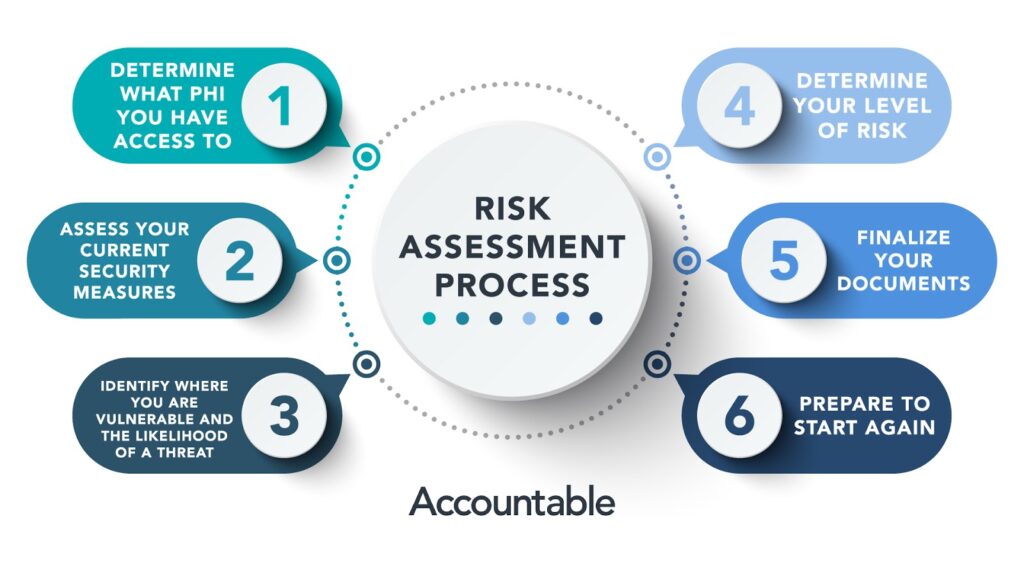
Steps Included In HIPAA Security Risk Assessment – PHCSS
Protecting patient data is important in the healthcare industry. The benchmark for safeguarding private patient information is established by the Health Insurance Portability and Accountability Act (HIPAA). A HIPAA security risk assessment is not only required by law, but it is also an important step in guaranteeing the availability, confidentiality, and integrity of medical records. At PHCSS, we follow all required steps to make sure that HIPAA security risk assessment is done properly. In this way, we can offer the best healthcare services in town. In this blog, we will lead you through each of the important steps needed to carry out a HIPAA security risk assessment.
What Is HIPAA Security Risk Assessment?
As mandated by the Health Insurance Portability and Accountability Act (HIPAA), a HIPAA security risk assessment is a thorough analysis of an organization’s systems, procedures, and policies to identify potential threats and vulnerabilities to the security of electronic protected health information (ePHI). The evaluation seeks to verify adherence to the HIPAA Security Rule, which requires security measures to preserve the availability, confidentiality, and integrity of electronic health information. It entails determining risks, evaluating the efficacy of current security controls, setting remediation priorities, and putting discovered risks and mitigation. Regular risk assessments lower the chance of data breaches and protect patient privacy by assisting healthcare businesses in proactively identifying and addressing security gaps.
Steps Included In HIPAA Security Risk Assessment
Here are the main steps included in HIPAA security risk assessment.
Step 1: Understand HIPAA Requirements
It is essential to understand the HIPAA Security Rule thoroughly before beginning the evaluation procedure. Learn about the main provisions, such as the technical, administrative, and physical safety measures. The steps healthcare institutions must take to secure electronic protected health information (ePHI) are outlined in these safeguards.
Step 2: Identify Scope and Assets
Determine the systems, procedures, and personnel in your organization that handle ePHI in order to define the scope of your assessment. Personnel, software, hardware, and network infrastructure are all included in this. Make an asset inventory to guarantee thorough coverage during the evaluation.
Step 3: Conduct Risk Identification
Determine any dangers or weak points that can jeopardize ePHI security. Vulnerabilities could be obsolete software, weak passwords, or insufficient access restrictions, whereas threats could be hostile actors, natural calamities, or human error. Sort dangers according to likelihood and potential effects on the security of patient data.
Step 4: Assess Current Security Controls
Analyze how well the current security measures are reducing the dangers that have been identified. Examining protocols, guidelines, and technological safeguards like firewalls, encryption, and access controls are all part of this. Check to see if controls are appropriately applied and adequate to address threats and vulnerabilities that have been identified.
Step 5: Gap Analysis
To find out where the security measures in place don’t meet HIPAA regulations, do a gap analysis. Track down and prioritize any discrepancies between current controls and HIPAA standards that may affect the security of electronic patient health information. Remedial strategy formulation will be guided by this analysis.
Step 6: Develop a Remediation Plan
Create a thorough remediation strategy based on the results of the gap analysis and risk assessment. This plan should specify precise steps to close gaps found and successfully reduce risks. Set deadlines, assign roles, and provide funds to guarantee that repair actions are carried out on time.
Step 7: Implement Security Measures
Put into practice the security measures specified in the remediation plan, paying particular attention to closing compliance gaps and fortifying weak points. This could entail changing policies and processes, improving access restrictions, supplying staff training, or applying security updates. To make sure the strategy is followed, keep a constant eye on the progress.
Step 8: Monitor and Review
Maintain the efficacy of security controls and compliance with HIPAA regulations by routinely monitoring and reviewing them. To find new vulnerabilities and threats, do regular security testing, risk assessments, and audits. As technology advances and conditions change, security measures should be updated accordingly.
Step 9: Document Everything
Keep detailed records of every step of the risk assessment process, including the conclusions, the actions taken to address the issues, and the ongoing monitoring programs. In the event of an audit or security incident, documentation can be used to show due care and act as proof of compliance.
Step 10: Continuous Improvement
HIPAA compliance is an ongoing process that needs to be improved upon and adjusted to new regulations and risks as they arise. Make sure your risk management plan takes into account the lessons you have learned from security incidents and audits, as well as any revisions to HIPAA standards and industry best practices.
Conclusion
In conclusion, these procedures help healthcare businesses strengthen their defenses against potential threats to patient data security and complete a thorough HIPAA security risk assessment. Ensuring adherence to HIPAA regulations helps in safeguarding confidential data and fostering patient trust in the healthcare system’s dedication to privacy and security. That is why we ensure to follow HIPAA regulations to ensure that our patients’ data is kept safe and best healthcare services are provided.






